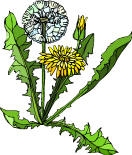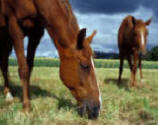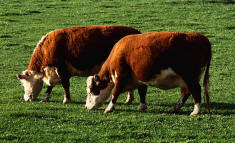

To send a message to an author, click on the author's name at the end of the article.
This Month in Ag Connection | Ag Connection - Other Issues Online
As the grass greens up producers begin to look forward to turning cattle onto spring pasture and discontinue feeding. As fall-born calves are weaned, producers must decide if adding weight by turning calves out on grass or backgrounding in a lot will be profitable. Likewise, as spring calves get older, whether or not to creep feed will become a common question. Value and cost of gain calculations will aid in these decisions.
Value of gain calculates the value of each additional pound of calf gain. As calves get heavier, the value per hundred weight declines while calf value increases. To determine the value of adding calf weight, determine the heavier calf value then subtract the lighter calf value and divide by pounds added. For example: (650 * $1.10) - (550 * $1.18) = $66 / 100 pounds = $0.66. Each additional pound added from 550 to 650 pounds is worth $0.66.
Cost of gain must be calculated and will vary depending on cattle performance, feed efficiency and feed cost. Expensive feed resulting in exceptional performance may result in a similar cost of gain as cheaper feed with lower performance. If creep feed costs $140 / ton or $0.07 / lb, and calves require 10 to 14 pounds of creep feed for each pound of additional gain, then feed cost of gain is $0.84. Using the value of gain from above, each additional pound added to the calf resulted in a $0.18 loss ($0.66 - $0.84 = - $0.18).
Placing calves in a backgrounding lot and feeding $140 / ton feed with calves converting at six pounds of feed to a pound of gain results in a $0.42 feed cost of gain. This example leaves $0.24 per pound of gain for yardage, treatment, interest, etc. Another example would be turning calves out on pasture with a grazing cost of gain at $0.40 / pound. In grazing systems stocking rate, animal performance and forage availability will influence cost of gain. Regardless of how calves are fed and managed the key is to do the calculations for your operation to determine if the value of gain outweighs the cost.
(Author: Justin Sexten, State Beef Extension Specialist - Nutrition Commercial Agriculture Program)
This Month in Ag Connection | Ag Connection - Other Issues Online
A weed is a undesired plant that grows out of place and competes with the desired plants for water, nutrients and space. If weeds are not controlled in your pasture they can reduce forage yield, lower forage quality, and cause animal injury through toxicity. The bottom-line is weeds cost you money. In order to reduce or prevent losses due to weeds, one should implement and maintain a weed management plan. This involves routinely scouting your fields, weed prevention and control.
Weed control can be achieved through cultural, mechanical, biological and chemical control methods. These methods can be used alone or in most cases in combination with each other.

Cultural management practices that promote a vigorous, healthy stand of the desired forage include; proper forage variety selection, good fertilization practices, maintaining an adequate pH and good harvest management, whether by grazing or haying. Soil testing is essential to insure the soil pH, phosphorus and potassium levels are adequate for the forage species.
Mowing or brush hogging are effective mechanical control in weed and brush management. When used alone, mowing hides a problem but rarely gives good control. The effectiveness of mowing is enhanced when used in combination with other control methods such as good fertilizer and liming practices and herbicide management. Mowing brush like sumac, hedge (Osage Orange) or honey locust can actually make the problem worse. A person can gain slow control over blackberries by timely mowing; namely, from full leaf to blossom in the spring. Even with proper mowing, one should expect control to take several years to make meaningful progress. A late-season mowing of blackberries or other species of brush is only cosmetic and will give no long-term control.
Biological control can be used to control targeted weed species. An example of a targeted species in Missouri is the musk thistle. The introduction of the musk thistle head and rosette weevils has been effective in reducing the population.
Chemical control involves the use of selective herbicides, and generally provides the most effective control of troublesome weeds once they have become established. Before using any herbicide, read and follow label directions to determine appropriate rates, carrier volume and spray additives. For the herbicide to be effective it is essential to accurately identify the weed you are trying to control.
To help you with weed identification the MU Weed Science program has a Weed ID guide that can be found at http://weedid.missouri.edu/index.cfm. For information with herbicide selection or plant identification contact your local MU Extension office.
(Author: Joni Ross, Agronomy Specialist -- Source: MP581 Pasture Weed & Brush Control)
This Month in Ag Connection | Ag Connection - Other Issues Online

Horse owners can effectively use pasture to serve two necessary functions related to the care of their horses. Pastures provide horses an effective place to exercise, but also, if properly managed, can provide a significant portion of the horse's nutrient requirements. It is important to remember that horses evolved as a grazing animal where forages provided all their nutrient needs, and many horses of today can be effectively maintained on well managed quality pastures. Table 1 shows the percentage of nutrients pasture can supply to a mature horse.
A common stocking rate recommendation is 2-4 acres per horse. This range is necessary because there is limited information on grazing pressure or stocking rate for horses, plus there is variation in available forage due to the difference in growing conditions. Restricting your available land base results in over grazed, unproductive pastures.
In order to provide ample forage, horse owners need to use best management practices for the pasture. This includes regular fertilization, weed control, forage selection using forage species appropriate for your location and appropriate grazing management to use the forage produced. Horses are noted spot grazers or a better term may be selective grazers. If ample forage is available, horses will select the highest quality forage in the pasture. This is generally the most immature material. In many situations, if not controlled, horses will graze that preferred forage until it is removed from the pasture, leaving bare ground. Consider the following management practices for your horse pastures.
Using a rotational grazing system with horses increases the likelihood of maintaining cool season species such as smooth brome or orchardgrass and legumes such as red clover or lespedeza in your pastures.
Because of excessive traffic, there will be areas of your pasture that will be difficult to maintain a vigorous stand of forage. These areas are commonly around feeders, waterers, shade and gates. Consider using crushed rock and geotextile fabric to create a pad in the area, rather than trying to keep these areas in grass.
Pasture has the potential to be an excellent source of feed for your horses. However, it requires management like any other crop.
(Excerpted from: Grazing Systems That Work With Horses; Bob Coleman Ph.D. Extension Horse Specialist; University of Kentucky, Lexington, Kentucky)
| Pasture Quality | % Nutrients Supplied | Supplemental Feed Required |
|---|---|---|
| Excellent (Spring Pasture) | Over 150% | Salt, minerals and water (caution as horses may become obese) |
| Very Good | 100% | Salt, minerals and water |
| Good | 70-100% | 6-7 pounds of good quality hay per day |
| Fair | 25-50% | 9-13 pounds of good quality hay per day |
| Poor (Drylot) | 0 | 20-25 pounds of hay (exercise only) |
This Month in Ag Connection | Ag Connection - Other Issues Online
Understanding the growth cycles of cool-season grasses will go a long way to improve the amount of forage you are able to harvest from your pastures. The following aspects of forage growth and management alternatives should allow you to improve pasture productivity.
Most cool-season grasses produce an average of 2/3 of their annual production in the spring and 1/3 in the fall. A major characteristic of spring growth is the production of seed. This seed production cycle results in a tremendous decline of forage quality from a livestock nutrition perspective. The seed production cycle also limits the amount of vegetative growth a plant will produce. This is due to plant hormones that are produced during the seed production stage which inhibit plant buds from initiating new leaf growth. If the seed production cycle can be interrupted, a plant will have many active buds develop into leaves. These leaves will continue to grow into the summer months, provided rainfall is adequate. You can have leafy, highly nutritious forage in July if you interrupt the seed production cycle AND do not overgraze the pasture.

Since leaves are the most nutritious part of the plant, a major goal of forage management is to maximize the amount of leaves your forages produce. The easiest way to maintain leafy pastures is to never let a seed head develop and produce seed. When you see seed heads in a pasture, cut them off! Preventing overgrazing also results in greater leaf production. Overgrazing will result in weak, slow growing, low quality, weed infested pastures.
How are you supposed to prevent seed head formation and not overgraze at the same time? First, you can rotationally graze pastures. Second, you can clip seed heads in late May. Third, you can fence off portions of your pasture and harvest some areas for hay, again by mid to late May.
Rotational grazing is a tool to control forage growth and harvest. You try to control the explosion of spring growth of cool-season grasses by quickly moving cattle through pastures. "Top off" as many pastures as you can during April and early May. This helps reduce seed head production. Since most people have more than one pasture, try the following management alternative. Instead of putting cows in one pasture and grazing it until nothing is left and then moving to the next pasture, try (in April and May) moving the cows to a new pasture every 4 or 5 days. In June, leave the cows in a pasture for 7 to 10 days. Your pastures will be more productive AND your cattle will be easier to handle.
Timely clipping or hay harvesting can also result in leafy, high quality cool-season grass pastures in July. Clipping to a 5 to 6 inch stubble height should be done as soon as seed heads emerge. If you harvest hay, you will need about 45 days re-growth before turning in livestock to maintain healthy, vigorous forage plants. Try to have some hay harvested by mid May in order to have high quality re-growth the first part of July. Nutrient losses due to rain are less than nutrient losses due to maturity.
These management ideas may not be easy to accomplish. They may not need to be incorporated into every acre you own. They are simply ideas you can try on certain area of your farm to see how they work for you. If you like the results, expand the management idea to more acres next year.
(Author: Gene Schmitz, Livestock Specialist)
This Month in Ag Connection | Ag Connection - Other Issues Online
Horse owners with limited acreage (less than 4 acres per horse) will need to consider fescue as the major forage in their horse pastures. No other forage will stand up as well to the abuse of grazing horses on small acreages. Owners should be cautioned, however, that pregnant and lactating mares need to be on forage other than endophyte infected fescue. However, the novel endophyte fescue Max-Q is safe for mares and is more persistent than endophyte free fescues.
For more information on managing horse pastures: http://www.extension.umn.edu/horse/components/pdfs/FactSheets/PastureManagement_08460.pdf
For more information on horses and horse management go to eXtension at: http://www.extension.org/horses
(Author: Mark Stewart, Livestock Specialist)
This Month in Ag Connection | Ag Connection - Other Issues Online
Publishing Information
Ag Connection is published monthly for Northeast and Central areas of Missouri producers and is supported by the University of Missouri Extension, the Missouri Agricultural Experiment Station, and the MU College of Agriculture, Food and Natural Resources. Managing Editor: Mary Sobba.